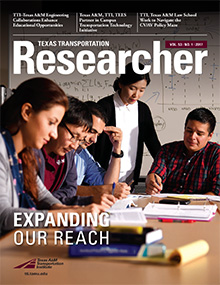The Texas A&M Transportation Institute (TTI) and the Texas A&M Engineering Experiment Station (TEES) are partnering under a contract with Texas A&M University to develop a smarter campus transportation ecosystem. Texas A&M University President Michael K. Young created the Campus Transportation Technology Initiative (CTTI) to bring private-sector transportation innovation into the real-world environment of a university campus to improve safety, mobility and quality of life.


“An early implementation and a big change on campus is at the intersection of Ross and Bizzell Streets that deployed innovative bicycle lane pavement markings that glow at night for cyclists,” says Bob Brydia, TTI’s senior research scientist leading the CTTI project. “The markings absorb solar power during the day and emit a soft glow to illuminate the bike paths within the intersection at night.”
The initiative’s goal is to encourage those with technologies that may improve a transportation environment to bring them to Texas A&M’s campus, where administrators and planners are looking to demonstrate and evaluate ideas. Using multiple, similar technologies in the same location can also show how synergies can be developed between technologies and modes. Texas A&M University Transportation Services, led by Associate Vice President Peter W. Lange, is TTI’s partner on the university side.
“We think we will see companies that will develop mobile apps and other innovative concepts that can help make alternative transportation options more seamless to commuters,” says Lange.
How It Works
An initial request for information, issued in June 2016 by TTI and TEES, generated responses from more than 30 companies, ranging from multinationals to entrepreneurs. The call is open through August 2017, and implementations and evaluations are currently scheduled through December 2017. Once a demonstration is in place on campus, TTI and its partners determine how well the technologies work, either independently or in combination, to address transportation issues in the campus environment.

Implementations currently taking place or being planned at Texas A&M include:
- solar luminescent bicycle pavement markings (a first in the United States) applied at the nation’s first unsignalized Dutch junction intersection;
- the first transit-fleet data collection in the country to support the improvement of Environmental Protection Agency emissions modeling;
- automated parking lot analytics using camera images and cloud-based processing;
- next-generation traffic-data-collection equipment;
- WiFi-based triangulation of transit fleet customers to examine bus-stop efficiencies and placements; and
- paper-based assessment of potential future modes of mass transport.
Academic Benefits
Academic partnerships are a key desired outcome of the initiative. The expansive environment of the Texas A&M campus — a mega-campus that provides access to large numbers of students while maintaining Texas A&M’s reputation as a high-end research university — provides a valuable, real-world laboratory in which Texas A&M students can help researchers test advanced technologies outside the classroom. Significant progress has been made to bring the evaluation of the projects into the classroom over the past semester, with Texas A&M colleges already involving students in the engineering, planning and policy aspects of the various technology deployments. With more than 15,000 students currently in the Texas A&M College of Engineering — and a goal of growing that number to 25,000 by 2025 — the university itself is augmenting the classroom experience for future transportation engineers currently studying at Texas A&M.
“This initiative provides hands-on opportunities for our students to implement real-world transportation innovations,” says M. Katherine Banks, vice chancellor and dean of Texas A&M Engineering. “From assessing a unique solar luminescent bicycle pathway to analyzing various intersection enhancements, the learning opportunities for our students are exceptional.”
Examples of projects students might be involved in include:
- qualitative assessment of bicycle markings;
- prototyping of the quantitative assessment of intersection movements via recorded video to examine behavior by modes (e.g., vehicles, pedestrians and bicycles);
- analysis of transit fleet data matching loadings to engine performance and emissions;
- comprehensive assessment of intersection function with new markings;
- development of a transit-demand prediction tool for new areas of demand, such as new student housing areas; and
- development of a trip-planning website combining multiple modes of travel and links between modes for the campus community.
